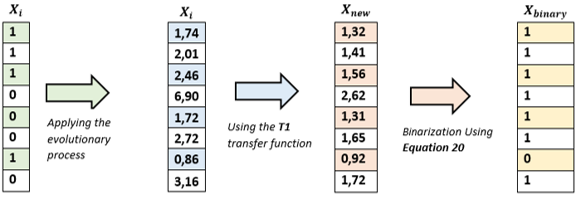Binary Aquila Optimizer with Taper-Shaped Transfer Function: An Application for Merkle-Hellman Knapsack Cryptosystems
DOI:
https://doi.org/10.58190/imiens.2025.125Keywords:
Aquila Optimizer, Taper-shaped transfer function, Merkle-Hellman Knapsack CryptosystemsAbstract
Metaheuristic algorithms are powerful methods used to solve large and complex optimization problems. Thanks to their flexibility, they provide effective results in various fields and also have an important place in security applications such as the Merkle-Hellman Knapsack Crypto System. Aquila Optimizer is an optimization algorithm inspired by the hunting behavior of aquilas. It provides fast and effective solutions to complex problems. In this study, Aquila Optimizer is discretized using taper-shaped transfer functions. Taper-shaped transfer functions help the algorithm obtain more precise and effective results by increasing its performance. Four BinAO versions obtained in this way were tested on the Merkle-Hellman Knapsack Cryptosystem. In the tests conducted for the cryptanalysis of "CAT" and "MACRO" messages, the version achieved more successful results. Additionally, tests conducted with the algorithms in the literature clearly showed that the proposed algorithm is successful and effective.
Downloads
References
[1] C. Blum and A. Roli, "Metaheuristics in combinatorial optimization: Overview and conceptual comparison," ACM computing surveys (CSUR), vol. 35, no. 3, pp. 268-308, 2003.
[2] S. Vaudenay, A classical introduction to cryptography: Applications for communications security. Springer, 2006.
[3] M. Abdel-Basset, R. Mohamed, I. M. Hezam, and K. M. Sallam, "Performance Optimization and Comprehensive Analysis of Binary Nutcracker Optimization Algorithm: A Case Study of Feature Selection and Merkle–Hellman Knapsack Cryptosystem," Complexity, vol. 2023, 2023.
[4] H. Grari, S. Lamzabi, A. Azouaoui, and K. Zine-Dine, "Cryptanalysis of Merkle-Hellman cipher using ant colony optimization," Int J Artif Intell ISSN, vol. 2252, no. 8938, p. 8938, 2021.
[5] N. Kantour and S. Bouroubi, "Cryptanalysis of merkle-hellman cipher using parallel genetic algorithm," Mobile Networks and Applications, vol. 25, no. 1, pp. 211-222, 2020.
[6] S. Sikdar, J. Biswas, and M. Kule, "Cryptanalysis of Markle Hellman Knapsack Cipher Using Cuckoo Search Algorithm," in International Conference on Frontiers in Computing and Systems, 2022: Springer, pp. 147-160.
[7] M. Abdel-Basset, R. Mohamed, and O. M. Elkomy, "Knapsack Cipher-based metaheuristic optimization algorithms for cryptanalysis in blockchain-enabled internet of things systems," Ad Hoc Networks, vol. 128, p. 102798, 2022/04/01/ 2022, doi: https://doi.org/10.1016/j.adhoc.2022.102798.
[8] M. Abdel-Basset, D. El-Shahat, I. El-henawy, A. K. Sangaiah, and S. H. Ahmed, "A Novel Whale Optimization Algorithm for Cryptanalysis in Merkle-Hellman Cryptosystem," Mobile Networks and Applications, vol. 23, no. 4, pp. 723-733, 2018/08/01 2018, doi: 10.1007/s11036-018-1005-3.
[9] S. Sikdar, J. Biswas, and M. Kule, "Cryptanalysis of Markle-Hellman knapsack cipher using nature inspired algorithms," International Journal of Applied Cryptography, vol. 5, no. 1, pp. 41-56, 2024.
[10] M. Abdel-Basset, R. Mohamed, I. M. Hezam, K. M. Sallam, and I. A. Hameed, "An efficient binary hybrid equilibrium algorithm for binary optimization problems: analysis, validation, and case studies," International Journal of Computational Intelligence Systems, vol. 17, no. 1, p. 98, 2024.
[11] M. Abdel-Basset, R. Mohamed, S. Saber, I. M. Hezam, K. M. Sallam, and I. A. Hameed, "Binary metaheuristic algorithms for 0–1 knapsack problems: Performance analysis, hybrid variants, and real-world application," Journal of King Saud University-Computer and Information Sciences, vol. 36, no. 6, p. 102093, 2024.
[12] M. Abdel-Basset, D. El-Shahat, I. El-Henawy, A. K. Sangaiah, and S. H. Ahmed, "A novel whale optimization algorithm for cryptanalysis in Merkle-Hellman cryptosystem," Mobile Networks and Applications, vol. 23, pp. 723-733, 2018.
[13] A. Agarwal, "Encrypting messages using the Merkle-Hellman knapsack cryptosystem," IJCSNS, vol. 11, no. 5, p. 12, 2011.
[14] R. Merkle and M. Hellman, "Hiding information and signatures in trapdoor knapsacks," IEEE Transactions on Information Theory, vol. 24, no. 5, pp. 525-530, 1978, doi: 10.1109/TIT.1978.1055927.
[15] S. Mahajan, L. Abualigah, A. K. Pandit, and M. Altalhi, "Hybrid Aquila optimizer with arithmetic optimization algorithm for global optimization tasks," Soft Computing, vol. 26, no. 10, pp. 4863-4881, 2022.
[16] L. Abualigah, D. Yousri, M. Abd Elaziz, A. A. Ewees, M. A. Al-Qaness, and A. H. Gandomi, "Aquila optimizer: a novel meta-heuristic optimization algorithm," Computers & Industrial Engineering, vol. 157, p. 107250, 2021.
[17] G. Yildizdan and E. Bas, "A new binary coati optimization algorithm for binary optimization problems," Neural Computing and Applications, vol. 36, no. 6, pp. 2797-2834, 2024.
[18] Y. He, F. Zhang, S. Mirjalili, and T. Zhang, "Novel binary differential evolution algorithm based on Taper-shaped transfer functions for binary optimization problems," Swarm and Evolutionary Computation, vol. 69, p. 101022, 2022.
[19] B. Crawford, R. Soto, G. Astorga, J. García, C. Castro, and F. Paredes, "Putting continuous metaheuristics to work in binary search spaces," Complexity, vol. 2017, no. 1, p. 8404231, 2017.
[20] A. Jain and N. S. Chaudhari, "Cryptanalytic results on knapsack cryptosystem using binary particle swarm optimization," in International Joint Conference SOCO’14-CISIS’14-ICEUTE’14: Bilbao, Spain, June 25th-27th, 2014, Proceedings, 2014: Springer, pp. 375-384.
[21] S. Palit, S. N. Sinha, M. A. Molla, A. Khanra, and M. Kule, "A cryptanalytic attack on the knapsack cryptosystem using binary firefly algorithm," in 2011 2nd International conference on computer and communication technology (ICCCT-2011), 2011: IEEE, pp. 428-432.
[22] S. N. Sinha, S. Palit, M. A. Molla, A. Khanra, and M. Kule, "A cryptanalytic attack on Knapsack cipher using differential evolution algorithm," in 2011 IEEE Recent Advances in Intelligent Computational Systems, 2011: IEEE, pp. 317-320.

Downloads
Published
Issue
Section
License
Copyright (c) 2025 Intelligent Methods In Engineering Sciences

This work is licensed under a Creative Commons Attribution-ShareAlike 4.0 International License.






